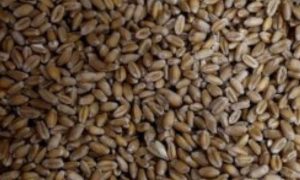Russia announces wheat export quota

Amid rising domestic food inflation and dwindling wheat stocks, Russia has reduced its 2025 wheat export quota to 11 million tonnes, down from 29 million tonnes, and increased export duties to protect domestic supplies. Wheat exports from July to November set records despite a reduced 2024 harvest. Tight quotas and reduced inventories signal a global supply gap, particularly for North Africa and the Middle East.
WITH domestic food inflation rising and wheat stocks rapidly dwindling, the Russian Government has announced a significant reduction to its 2025 wheat export quota and increased export duties to preserve domestic supplies. The news came as no surprise to the market, with the pace of wheat exports setting all sorts of records from July to November, the first five months of the current marketing year, despite a sharp reduction in output from the 2024 harvest.
Russia’s customs sub-commission reported on Friday that it had approved a wheat export quota of 11 million tonnes (Mt) for the second part of the marketing year from 15 February to 30 June 2025, down from 29Mt in the same period this year. In a separate communiqué, Russia’s agriculture ministry raised the wheat export duty by over 18 percent, or around US$6/t, from December 4.
In a statement, the Russian Economic Development Ministry said: “The sub-commission at a meeting approved a tariff quota for the export of grain crops from Russia to states that are not members of the Eurasian Economic Union from February 15 to June 30, 2025, in the amount of 11Mt. The quota includes only wheat and meslin. The quota to export barley, rye and corn will be zero tonnes.”
“We are strengthening control over the export of agricultural products to prioritise the supply of the domestic market. These measures should stabilise the price situation,” said Deputy Prime Minister for Agriculture Dmitry Patrushev.
The EEU Council reported the quota changes concurrently. The EEU comprises Armenia, Belarus, Kazakhstan, Kyrgyzstan, and Russia, and coordinates its members’ customs and tariff policy.
Russia permits quota-free grain exports from July to January each year, a period referred to as the first half of the export season, and then implements quotas among about 260 domestic traders authorised to sell grain internationally from February 15 to June 30.
Moscow initially introduced grain-export quotas back in 2020 when an all-grain sales limit of 7Mt was set for the April 1-June 30 window. A new limit of 17.5Mt was implemented from 15 February to 30 June 2021, and late that year, Moscow decided the quota would become an annual measure effective from February 15 to June 30.
In 2022, the quota was set at 11Mt, including 8Mt of wheat. In 2023, it increased to 25.5Mt without specific commodity restrictions. The 2024 quota was initially set in December of 2023 at 24Mt but was increased to 29Mt in April this year with no differentiation between grain types.
In early November, Russia’s Agriculture Minister, Oksana Luth, reported 76pc of last year’s quota had been exhausted, and exporters that did not fully use their quota will have their allocations proportionally reduced through a correction coefficient in 2025. This policy appears to be a departure from recent methodology, where second-half quota volumes were based on export share in the first half of the season.
Market analysts had been widely expecting last week’s announcement, with wheat quota speculation predominantly in the 9-11Mt range. Late last month, Black Sea market analyst SovEcon reduced its 2024-25 wheat-export forecast by 1.8Mt to 44.1Mt based on the expectation of a tight export quota. That would put this year’s program well behind last season’s record 52.4Mt task, but still ahead of the five-year average of 40.9Mt.
However, according to the Russian Grain Union, wheat exports in November could be as high as 4.8Mt, and shipments from the beginning of July to the end of November could hit 26.7Mt, higher than last year’s 26.6Mt record for the first five months of the export program. RGU is working on a total 2024-25 wheat export campaign of 45Mt, which leaves 18.3Mt to export for the balance of the marketing year. Accounting for the new quota puts exports at 7.3Mt over the traditionally slower winter shipping period of December 1-February 15.
Reduced inventory
SovEcon has also been reporting a sharp reduction in wheat inventories held in farm storage across the country compared to last season. As of November 1, SovEcon reported total on-farm stocks at 21.8Mt, down 20pc year on year. Stocks held in the Southern Federal District, the top exporting region of Russia, were just 6.3Mt, 26pc lower than at the same time in 2023.
The USDA’s November supply-and-demand update had Russian exports at 48Mt, which means a correction is expected in the December report. It also creates a global supply gap. with the European Union and other Black Sea origins likely to fight for a share of North African and Middle Eastern wheat demand in the first half of 2025 and Australian and Argentinian exporters to compete for a greater share of the Asia pie.
Cash is king
With relatively low global wheat prices, the Russian farmer has found a new ally, encouraging liquidation of farm stocks instead of withholding from the market in the hope of higher prices. The Central Bank of Russia increased its key interest rate to 21pc in October, the highest level in more than 20 years, as it battles rising inflation in an overheated economy. Several banks are reportedly offering interest rates as high as 25pc on short-term deposits. This is the ultimate, low-risk carry trade for farmers who can sell now and bank the money for a guaranteed return of around US$3.50/t per month without having to sweat on a market rally over winter.
The frustration of low wheat prices, poor yields and heavy losses this year also has the Russian farmer looking for more profitable cropping alternatives moving forward. The area planted to wheat has reportedly decreased in the current seeding program, with a swing to more niche commodities such as peas, lentils, and sunflowers reported.
Meanwhile, the Russian ruble has plunged to its lowest rate against the US dollar since March of 2022 in the wake of new Western sanctions and escalating geopolitical tensions. The ruble traded at more than 113 to the dollar last Wednesday before rallying to 106.5 into Friday’s close. This compares to 96 just a month ago, the one-year high of 83.5 on June 19 and the pre-war level of around 70 to the dollar. The weak ruble adds to producer and exporter profitability while holding nearby Russian export values below the supposed floor price for the moment. However, with the quota now set, global concerns over Black Sea wheat supply should remedy that situation in due course.
To read more about Wheat News continue reading Agriinsite.com
Source : Grain Central
















